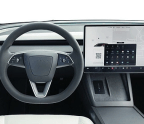

We like our comparison tests to come to definitive conclusions. This time, though, in pitting the all-new 2022 Toyota Tundra against the bestselling Ford F-150, it came down to the details. One of these pickup trucks has a better engine, the other a better transmission. One has a better-looking interior; the other offers better functionality. Even the back seat factors into the equation: One has a better seat, the other smarter floor storage. We did manage to pick a winner, but only by the slimmest of margins. If you were to purchase the truck we deemed the lesser of the two, we certainly wouldn’t say you bought the wrong one.
But enough preamble, let’s meet our players. We decided to sample workaday, lower-trim versions of these full-size trucks. Both featured crew cabs,
short boxes, and four-wheel drive. Toyota sent along a 2022 Tundra Limited equipped with the TRD Off-Road package and a handful of other useful stand-alone options that added up to a $60,188 sticker. Ford supplied an F-150 XLT, the truck’s one-up-from-the-bottom trim, which was priced at $58,575 and fitted with two key options—Ford’s Max Trailer Tow package and the 3.5-liter EcoBoost twin-turbo V-6. (The truck Ford sent was a 2021, but the 2022 F-150 is functionally identical.)

At first glance the F-150 is the slightly






